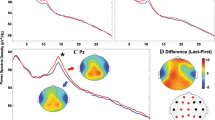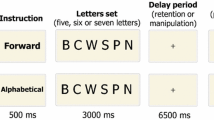Summary
EEG-signals were recorded from subjects as they performed a modified version of Schneider's and Shiffrin's memory search paradigm. The hypothesis was tested whether individual (centre of gravity) alpha frequency, termed IAF, is related to memory performance and/or attentional demands. The results show that memory performance exerts the strongest effect on IAF. As compared to a resting period, the difference in IAF between age-matched good and bad memory performers reached a maximum when subjects were actually retrieving information from their memory. During retrieval, the IAF of good performers is 1.25 Hz higher than for bad performers. Attentional and task demands also tend to reduce IAF, but- as compared to memory performance - to a much lesser degree. The results of amplitude analyses demonstrate further that during retrieval, alpha desynchronization is more pronounced for bad performers than for good performers. Taken together, the results indicate that a decrease in IAF is always related to a drop in performance.
Similar content being viewed by others
References
Adrian, E.D. and Matthews, B.H.C. The berger rhythm: Potential changes from the occipital lobes in man. Brain, 1934, 57: 355–385.
Andersen, P. and Andersson, A.A. Physiological basis of the alpha rhythm. New York: Century Crofts, 1968.
Bauer, R.H. Short-term memory: EEG alpha correlates and the effect of increased alpha. Behavioral Biology, 1976, 17: 425–433.
Berger, H. Über das Elektroenzephalogramm des Menschen. Archiv für Psychiatrie und Nervenkrankheiten, 1929, 87: 527–550.
Coben, L.A., Danziger, W. and Storandt, M. A longitudinal EEG study of mild senile dementia of Alzheimer type: Changes at 1 year and at 2,5 years. Electroencephalography and Clinical Neurophysiology, 1985, 61: 101–112.
Donchin, E., Kutas, M. and McCarthy, G. Electrocortical indices of hemispheric utilization. In S. Harnad, R.W. Doty, L. Goldstein, J. Jaynes and G. Krauthamer (Eds.), Lateralization in the nervous system. New York: Academic Press, 1977: 339–384.
Earle, J.B. Task difficulty and EEG alpha asymmetry: An amplitude and frequency analysis. Neuropsychobiology, 1988, 20: 96–112.
Games, P.A. Programs for robust analyses in ANOVA's with repeated measures. Psychophysiology, 1976, 13: 603.
Hadley, J.M. Some relationship between electrical signs of central and peripheral activity during "mental work". Journal of Experimental Psychology, 1941, 28: 53–62.
Kawabata, N. Nonstationary power spectrum analysis of the photic alpha blocking. Kybernetik, 1972, 12: 40–44.
Kinsbourne, M. and Hiscock, M. The normal and deviant development of functional lateralization of the brain. In: P.H. Mussen (Ed.), Carmichael's manual of child psychology, New York: John Wiley, 1983: 157–208.
Klimesch, W., Pfurtscheller, G., Mohl, W. and Schimke, H. Event-related desynchronization, ERD-mapping and hemispheric differences for words and numbers. International Journal of Psychophysiology, 1990a, 8: 279–308.
Klimesch, W., Schimke, H., Ladurner, G. and Pfurtscheller, G. Alpha frequency and memory performance. Journal of Psychophysiology, 1990b, 4: 381–390.
Knott, J.R. Brain potentials during silent and oral reading. Journal of General Psychology, 1938, 18: 57–62.
Koepruner, V., Pfurtscheller, G. and Auer, L.M. Quantitative EEG in normals and in patients with cerebral ischemia. In G. Pfurtscheller, F. Lopes da Silva and J. Jonkman (Eds.), Brain ischemia, quantitative EEG and imaging techniques (Progress in Brain Research, Amsterdam: Elsevier, 1984, Vol. 62: 29–50.
Llinas, R.R. The intrinsic electrophysiological properties of mammalian neurons: Insights into central nervous system function. Science, 1988, 242: 1654–1664.
Martinson, D.M. A study of brain potentials during mental blocking. Journal of Experimental Psychology, 1939, 24: 143–156.
Osaka, M. Peak alpha frequency of EEG during a mental task: Task difficulty and hemispheric differences. Psychophysiology, 1984, 21 (1): 101–105.
Osaka, N. Peak frequency of alpha activity shifts during mental tasks: Hemispheric differences. Electroencephalography and Clinical Neurophysiology, 1981, 52: 53.
Pfurtscheller, G. and Aranibar, A. Event-related cortical desynchronization detected by power measurements of scalp EEG. Electroencephalography and Clinical Neurophysiology, 1977, 42: 817–826.
Pfurtscheller, G. and Klimesch, W. Event-related desynchronization during motor behavior and visual information processing. In C.H.M. Brunia, G. Mulder and M.N. Verbaten (Eds.), Event-related brain research, Amsterdam: Elsevier, 1991: 58–65.
Pfurtscheller, G., Maresch, H., and Schuy, S. Inter- and intrahemispheric differencs in the peak frequency of rhythmic activity within the alpha band. Electroencephalography and Clinical Neurophysiology, 1977, 42: 77–83.
Pfurtscheller, G., Steffan, J. and Maresch, H. ERD mapping and functional topography: Temporal and spatial aspects. In G. Pfurtscheller and F.H. Lopes da Silva (Eds.), Functional Brain Imaging, Toronto: Hans Huber, 1988: 117–130.
Saletu, B. and Grünberger, J. Memory dysfunction and vigilance: Neurophysiological and psychopharmacological aspects. Annals of the New York Academy of Sciences, 1985, 444: 406–427.
Schneider, W. and Shiffrin, R.M. Controlled and automatic human information processing: I. Detection, search, and attention. Psychological Review, 1977, 84 (1): 1–66.
Stewart, M. and Fox, S.E. Do septal neurons pace the hippocampal theta rhythm? Trends in Neuroscience, 1990, 13: 163–168.
Treisman, M. Temporal rhythms and cerebral rhythms. Annals of the New York Academy of Sciences, 1984, 423: 542–565.
Vasey, M.W. and Thayer, J.F. The continuing problem of false positives in repeated measures ANOVA in psychophysiology: A multivariate solution. Psychophysiology, 1987, 24 (4): 479–486.
Wechsler, D.A. A standardised memory scale for clinical use. Journal of Psychology, 1945, 19: 87–95.
Author information
Authors and Affiliations
Additional information
This research was supported by the Austrian "Fonds zur Förderung der wissenschaftlichen Forschung", project S-4904 and S-4902.
Rights and permissions
About this article
Cite this article
Klimesch, W., Schimke, H. & Pfurtscheller, G. Alpha frequency, cognitive load and memory performance. Brain Topogr 5, 241–251 (1993). https://doi.org/10.1007/BF01128991
Accepted:
Issue Date:
DOI: https://doi.org/10.1007/BF01128991




